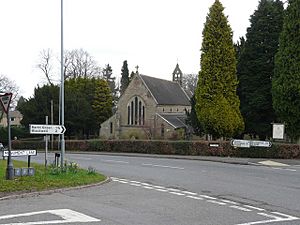Holy Trinity Church, Lickey facts for kids
Quick facts for kids Holy Trinity Church, Lickey |
|
|---|---|

Holy Trinity Church, Lickey
|
|
| 52°22′30.4″N 2°0′34.74″W / 52.375111°N 2.0096500°W | |
| Location | Lickey |
| Country | England |
| Denomination | Church of England |
| Website | lickeychurch.com |
| History | |
| Dedication | Holy Trinity |
| Consecrated | 6 June 1856 |
| Architecture | |
| Architect(s) | Henry Day |
| Groundbreaking | 16 May 1855 |
| Administration | |
| Parish | The Lickey |
| Deanery | Kings Norton |
| Archdeaconry | Birmingham |
| Diocese | Anglican Diocese of Birmingham |
Holy Trinity Church, Lickey, is a special church located in Lickey, Worcestershire, England. It belongs to the Church of England. This church has been an important part of the local community for many years.
Contents
Building the Church
The first stone for Holy Trinity Church was laid on May 16, 1855. A person named Robert Windsor-Clive (MP) helped start the building process. The church was originally built to help a larger church nearby, St John the Baptist Church, Bromsgrove. This meant it was a smaller, easier-to-reach place for people to worship.
Who Designed and Built It?
The church was designed by an architect named Henry Day, who was from Worcester. The company that built the church was John Robinson of Redditch. They worked hard to create the beautiful building we see today.
When the Church Opened
The church was officially opened and blessed on June 6, 1856. The Bishop of Worcester performed the special ceremony. This made it a proper place for people to gather and worship.
Changes Over Time
Over the years, Holy Trinity Church has been made bigger and improved.
Expanding the Church Building
Between 1893 and 1894, the church was expanded. A new area for the organ and a vestry (a room for clergy to prepare) were added. The vestry was built in 1898 and made even larger in 1970. These changes helped the church serve more people and activities.
Helping New Communities
The church also helped start a new mission in a nearby area called Rubery. In 1933, a part of the Lickey parish became its own new parish. This new parish was for St Chad's Church, Rubery. This shows how the church helped new communities grow.
The Church Organ
The church has a musical instrument called an organ.
About the Organ
An organ was built by Jon Nicholson and put into the church in 1856. You can find detailed information about this organ on the National Pipe Organ Register. Organs are large instruments that make music using pipes.
Churchyard and Famous People
The land around the church, called the churchyard, is a peaceful place.
A Famous Burial Site
A very famous person is buried in the churchyard of Holy Trinity Church. His name was Herbert Austin, 1st Baron Austin. He was a brilliant automobile designer and builder. He started the Austin Motor Company, which made many cars. Lord Austin lived nearby at a place called Lickey Grange.
See also
 In Spanish: Iglesia de la Santísima Trinidad (Lickey) para niños
In Spanish: Iglesia de la Santísima Trinidad (Lickey) para niños

